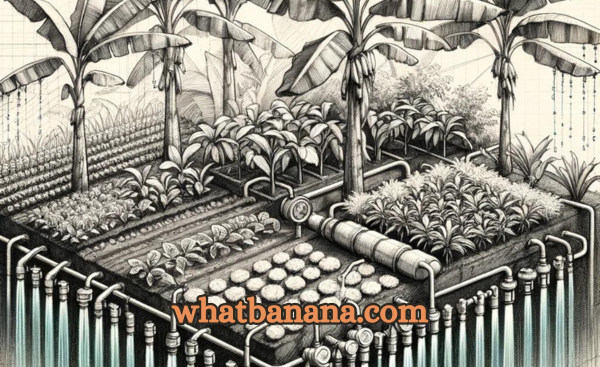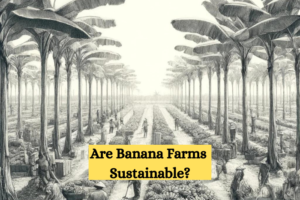Bananas, a popular global fruit, have significant environmental impacts. Large plantations contribute to deforestation and biodiversity loss. High agrochemical use leads to soil degradation and water pollution, while high water consumption exacerbates local scarcity. Sustainable practices like crop rotation, organic farming, and certification by Rainforest Alliance and Fairtrade are crucial. Consumers can support eco-friendly practices by choosing certified bananas, promoting better farming methods, and improving the livelihoods of workers.
It’s hard to walk through a grocery store and not notice bananas. As one of the most consumed fruits worldwide, their constant presence on our kitchen counters speaks volumes about their popularity.
But behind every bunch lies a story—one that’s not just about taste and convenience but about the environmental implications of their journey from farm to table. Banana plantations often span vast areas of tropical regions, and their impact on the environment can be significant.
To keep up with the global demand, these farms sometimes expand at the cost of precious natural forests, leading to considerable biodiversity loss. This expansion is more than an issue of space; it represents a disruption to entire ecosystems.
The challenge doesn’t stop with land use. Banana cultivation is typically a high-input agribusiness, relying on substantial amounts of agrochemicals.
The frequent applications of pesticides and fungicides necessary to maintain monoculture plantations can lead to soil degradation, water pollution, and health risks for workers and nearby communities. Another point of concern is water consumption.
🍌 Global Popularity of Bananas🍌 |
|
|---|---|
| Bananas Consumed Annually | Over 100 Billion |
| Top Banana-Producing Countries | India, China, Philippines |
| Most Banana-Consuming Countries | USA, Brazil, Indonesia |
| Average Banana Consumption Per Person (USA) | 27 lbs (12.3 kg) annually |
| Brought to You by whatbanana.com 🍌 | |
Banana plants are thirsty, and in regions where water scarcity is already a problem, the strain on water resources can exacerbate local tensions and contribute to environmental stress. Techniques to manage and conserve water are critical, yet not always employed effectively or at all.
These sustainability issues aren’t confined to isolated areas. From Latin America to Southeast Asia, banana production has echoed similar environmental challenges.
The situation calls for attention because the ramifications of unsustainable practices extend beyond localities and can affect the global community. As I wrap up this section, I’ll transition to discussing how the banana industry is addressing these challenges.
In the following segment, strategies and innovations promoting more sustainable banana farming practices come to the fore. Through certification schemes, ethical sourcing, and advances in agricultural techniques, there is a pathway toward a more responsible and sustainable banana industry.
Keep reading to explore how this transformation is taking shape and what role consumers can play in it.
Strategies and Innovations for Sustainable Banana Farming

Despite the challenges posed by traditional banana cultivation methods, numerous solutions and innovations pave the way for more sustainable practices. Certifying organizations, such as Rainforest Alliance and Fairtrade International, have been instrumental in setting standards that promote eco-friendly and socially responsible farming.
Farms that adhere to these guidelines often implement water conservation measures, agroforestry, and organic farming tactics to mitigate environmental impact. Success stories are emerging from corners of the globe where sustainable practices have been embraced.
Plantations that operate with a smaller ecological footprint have adopted methods like crop rotation, natural pest control, and the use of organic fertilizers. These practices not only maintain soil health and reduce pollution but also set a precedent for the industry.
Additionally, effective spacing strategies play a crucial role in sustainable banana farming by ensuring optimal plant growth and resource use.
Beyond traditional practices, cutting-edge farming techniques are also being explored. Precision agriculture, which includes the use of data analytics and controlled-release fertilizers, is on the rise.

These methods help farmers apply the exact amount of nutrients and water needed, minimizing waste and environmental damage. The power of ethical consumerism cannot be understated in driving change within the banana industry.
By choosing products that are certified as fair trade or Rainforest Alliance-certified, consumers signal their preference for sustainability, encouraging more farms to adopt better practices. Plus, such choices often support better livelihoods for workers in banana-producing countries.
Looking ahead, a combination of continued innovation, consumer action, and corporate responsibility is key to advancing sustainable banana farming. Outfitting more farms with the tools and knowledge to operate sustainably—and supporting them through the purchasing choices we make—is an essential step toward a greener planet.
My Final Thoughts
- Deforestation and Biodiversity Loss: Large banana plantations in tropical regions, such as those in Costa Rica, often replace natural forests, leading to significant biodiversity loss.
- Agrochemical Impact: In Ecuador, the high use of pesticides and fungicides in banana farming leads to soil degradation and water pollution, affecting both the environment and local communities’ health.
- Water Consumption: Banana farms in regions like the Philippines consume large amounts of water, worsening local water scarcity issues and causing stress on water resources.
- Sustainable Practices: Farms certified by Rainforest Alliance or Fairtrade, such as those in Colombia, adopt eco-friendly practices like organic farming and water conservation, reducing environmental impact.
- Consumer Influence: By choosing bananas with eco-certifications, consumers can support sustainable farming practices and better working conditions, influencing the market towards more responsible production methods.
Concerned individuals can JOIN THE MOVEMENT by staying informed about the origins of their food and opting for bananas that bear the mark of sustainability. How do you think consumers can play a more active role in promoting sustainable banana farming practices, and what changes would you be willing to make in your purchasing habits to support this cause?
Let me know in the comments below!
FAQ

1. What are the environmental impacts of banana farming?
- Banana farming can lead to deforestation and loss of biodiversity as large plantations often replace natural forests.
- The extensive use of pesticides and fungicides in banana cultivation can cause soil degradation and water pollution, affecting both the environment and local communities.
2. How does banana farming affect water resources?
- Banana plants require significant amounts of water, which can strain local water resources, especially in regions already facing water scarcity.
- Inefficient water management practices in banana farming can exacerbate local tensions over water usage and contribute to environmental stress.
3. What sustainable practices are being used in banana farming?
- Sustainable practices include crop rotation, organic farming, and the use of natural pest control methods, which help maintain soil health and reduce pollution.
- Certification schemes like Rainforest Alliance and Fairtrade promote eco-friendly farming techniques and encourage water conservation and agroforestry.
4. How can consumers support sustainable banana farming?
- Consumers can choose to buy bananas that are certified by organizations like Rainforest Alliance or Fairtrade, signaling their preference for eco-friendly practices.
- Supporting brands and retailers that prioritize ethical sourcing and sustainable farming methods can drive positive change in the industry.
5. What are the health risks associated with banana farming?
- The use of agrochemicals in banana farming poses health risks to farm workers and nearby communities, potentially causing respiratory issues and other health problems.
- Long-term exposure to pesticides and fungicides used in banana cultivation can lead to chronic health conditions and environmental contamination.
- Are Your Bananas Sustainable? The True Cost of Banana Production

- Grow Mighty Bananas: Essential Micro-Nutrients Revealed!

- Brace Your Bananas: Wind Damage Prevention

- Small Space, Big Harvest: Dwarf Banana Growing Secrets Unveiled

- Mastering the Art of Banana Sucker Choice!

- Go Bananas for Growth: Mastering Rhizome Planting!

